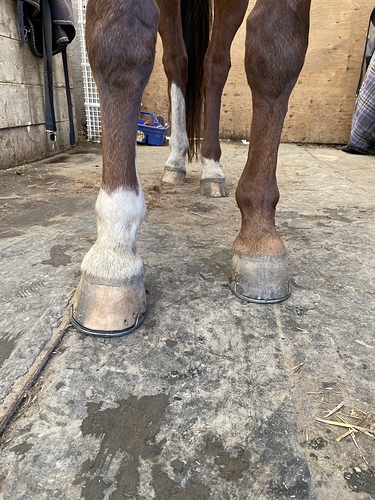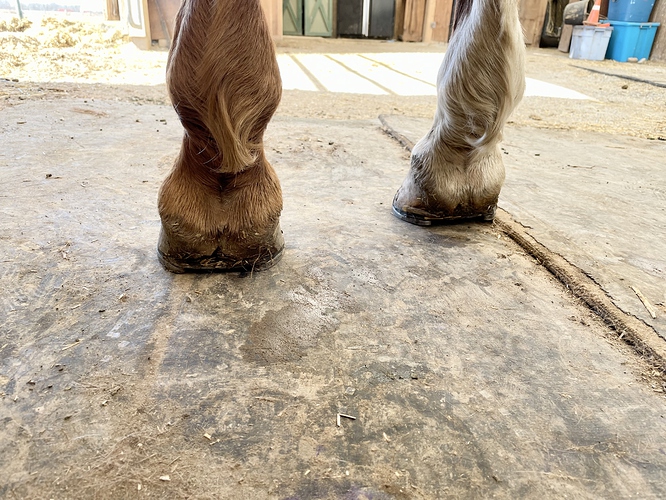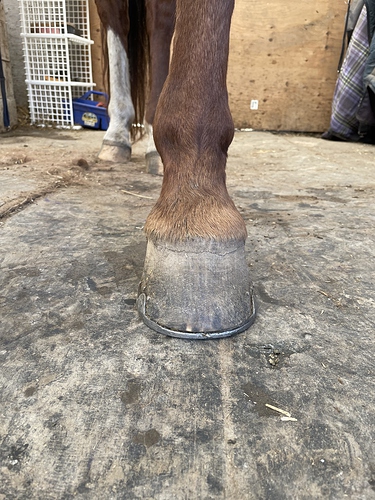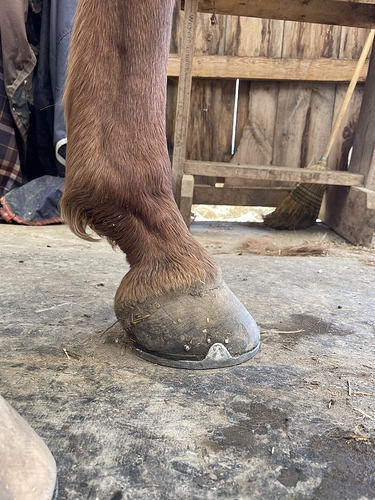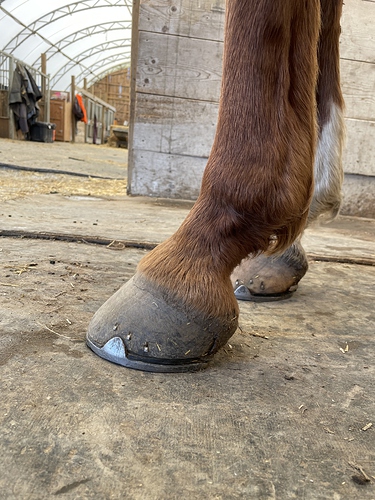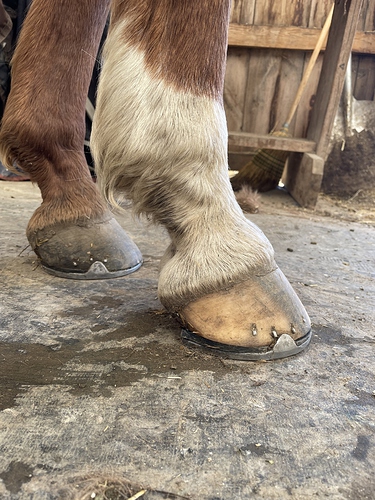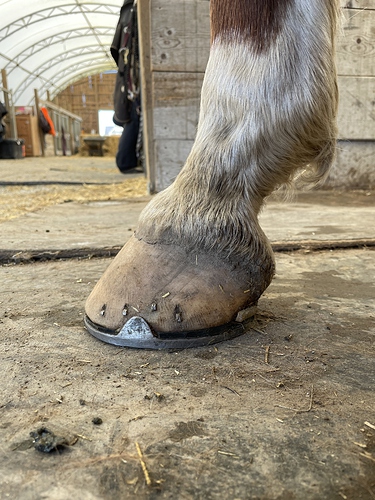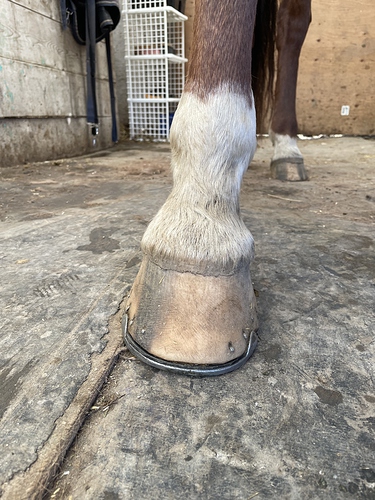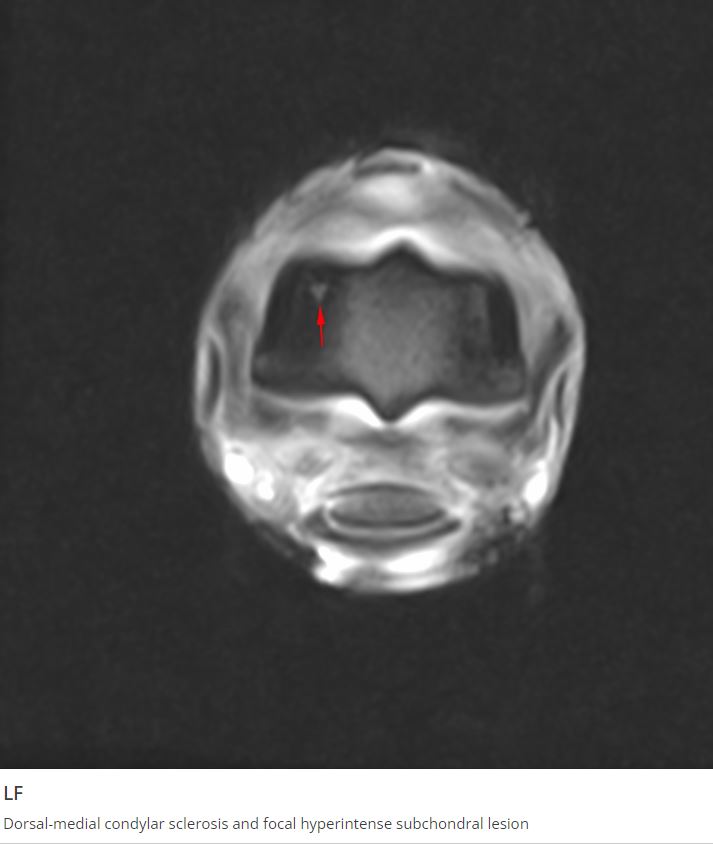@Alterration @IPEsq
I feel that the “twitching” is secondary to pain and asking her to walk. Tense through the front end while moving. While standing still there is no twitching/spasms/sweating. I can lift the foot and move her leg forward through her normal range of motion.
This is another reason why I’m kind of leaning toward heel pain. By the way she walks you’d think the leg is restricted, but it isn’t. She’s an opinionated mare, I don’t feel like she would let me stretch the legs forward if it was painful.
That makes absolute sense.
Yeah, if she is letting you stretch her legs, I’d lean toward foot pain of some ilk as well. Those little tendons inside the foot could be aggravated as well with the wedge pads (I know they were recommended, but that made my pre-navicular horse feel much worse). Golly. I hope she feels better and you get some good answers.
I’ve been following this thread but didn’t have anything much to add. But yesterday I was riding and thought of your mare. My gelding is barefoot and I use hoof boots on him sometimes when we’re going in the woods because of all of the stumps and sticks and stobs and stuff that can be tough on the feeties. Occasionally, even with the boots, he’ll step wrong or on something large enough that he takes a misstep. It got me thinking that he’s doing basically what your mare is doing, only for her it’s like she’s stepping on something with every step (even though she’s walking on smooth, clear ground).
So, all that to say, I’d think foot first too, especially since you mentioned being able to manipulate her legs and get full range of motion without a reaction.
It’s just odd that it comes on so suddenly and so sporadically. You’d think if there was an issue that can cause her to be that sore all of a sudden, it wouldn’t disappear for months at the time.
Best of luck finding out what it is. Keep us posted.
Thanks everyone. I’ll keep the thread updated. Lunged her last night and she picked up a big beautiful hack winning trot. She’s back to normal. I guess that’s good…
I saw once that a club foot can be secondary to shoulder or elbow issues (possibly OCD). The muscles from the shoulder down through the leg shorten due to pain/tension and cause the foot to be more upright. I’m not sure if this would apply here but something to consider, and I agree that if it’s changing sides then checking out the neck is a must.
Having just gone through this, I would do the ECVM neck x-rays. All the symptoms are typical of a horse with cervical issues, possible extending to first rib. I’m attaching the x-ray protocol created by the ECVM experts on the FB support group. Many vets don’t know to take these specific views.
ECVM INFO & X-RAY PROTOCOL.pdf (3.1 MB)
I may be overreacting, but if it was my mare, I wouldn’t be riding her until I had neck x-rays done. I may be getting more cautious as I age, but I’m concerned for your safety. Yes , my advice is worth exactly what you paid for it  but seriously, after watching that rope walk…
but seriously, after watching that rope walk…
I hope you find answers and that whatever is causing this will be an easy fix. It’s so odd.
UPDATE
We went ahead and did a standing MRI while the insurance claim was still open.
Mild bruising of the coffin bone and navicular bone in both front feet. No degenerative or soft tissue injuries. The bruising is more evident in the left front.
The other significant finding was a focal injury to the subchondral bone and overlying cartilage of the left front fetlock.
All things we couldn’t see on x-ray or ultrasound.
We suspect the NQR feeling I was getting was from the bone bruising in her feet, and probably why she initially felt better when we added shoes and pads.
The intermittent severe lameness is likely the result of the fetlock injury getting angry and irritated.
I haven’t spoken with my vet yet. But based on the recommendation of the vet who did the MRI our plan will likely be to give her most of the summer off. Starting with stall rest and then small solo turnout. We’ll keep shoes and pads on since fly stomping season is almost here. We may also do osphos and a biologic in the fetlock. And we’ll bring her back slowly in the fall.
Glad you got some answers! Jingles for a good recovery
I’m glad you got a diagnosis and that it wasn’t a muscle disease. Although it did look like lameness to me.
Can you use soft ride boots on her rather than shoes to ease some of the bruising? What sort of footing do you ride on? Perhaps she needs a softer footing?
My mare who ties up is mostly lame at the canter. Mentally she always wants to go which means you can’t trust her to not overdo it and make herself sick. We rode for 50 minutes the other day and she went right past the trailer on the way back and wanted to keep going. Mentally she’s great. Physically she can’t do it and she was already getting stiff from too much continual movement.
It’s absolutely a very odd disorder because I don’t think she is acutely painful. She just runs out of energy and slows way down. It feels like a mechanical lameness unless you keep going and then it may turn into a recognizable tying up issue. She doesn’t seem painful, just moves a bit stiff. She’s 20 this year. As a young horse she never recognizably tied up. It took years for me to figure out what was wrong and when it did present it looked a lot like colic. A horse that colics on rides may actually be tying up as they don’t always present with muscle fasciculations. I probably should do a video on her just for educational purposes. It’s a shame because she is incredible on trails and really is an amazing horse if you work around her limitations.
The footing is good where we ride and where she was turned out. I suspect the bruising has more to do with her short pasterns. She has good strong feet with good sole depth, but it looks like there’s too much concussion coming down the leg.
I’ll speak to my farrier and trainer about shoes/pads vs boots while she’s on stall rest. Still waiting to talk to my vet about some treatment options.
There were just too many things with her lameness that didn’t fit with a muscle disease. NQR being more obvious to me while on a circle vs straightaway. The initial improvement when we first put shoes and pads on. Her being happy to eat, drink, do stretches even while dead lame. Definitely not anything resembling colic.
Don’t forget fly boots. They can really reduce stomping.
Ah thank you! This hadn’t even crossed my mind. Any recommendations? I’ll usually be out 5 days/wk to handwalk and can ask the staff and some friends to keep an eye out for rubs.
I got annoyed at lack of shipping to Canada, and then giant shipping charges within Canada, so I went for cheapies that looked fairly sturdy off Amazon. They seem ok, but I’ve not used them long enough to give a fair recommendation.
Her heels look extremely contracted to me. Healthy heel bulbs will absorb concussion.
I wonder if she occasionally interfere or otherwise bangs that fetlock and that’s why you are seeing occasional lameness. You can get fetlock guards meant for bed sores but they might help with this too.
Her left front has always been a struggle (we bought her as a weanling, coming 7 now). She grows a lot of heel on that foot, and she has always had the habit of grazing RF forward, LF back. We had to pull her shoes off for the MRI so this is the first time I’ve gotten a good look since we put the shoes/pads on in January. She was barefoot prior.
They actually look quite good, the vet who did the MRI was happy with the trim.
We’ll certainly have to work to keep her feet healthy going forward.
There’s no evidence that she ever interferes.
Any recommendations?
Shoofly all day. Had them for years, no rubs with 24/7 wear on some thin skinned red heads! I usually get a new set each year but I have some from last season still in use. Despite the stays ripping through parts those boots still stay up and no sharp edges.
There are some knockoffs floating around but the shoofly legging style are the only ones I’ve found to work.
Ah thank you! This hadn’t even crossed my mind. Any recommendations? I’ll usually be out 5 days/wk to handwalk and can ask the staff and some friends to keep an eye out for rubs.
Shoo Fly - you can get them in Canada at Sharpe Farm Supplies, Bahrs, Pleasant Ridge, Greenhawk among other options.
I use ShooFly boots and my guy literally does not stomp at all.
Here is a copy of the report and one of the MRI images for anyone interested.
Findings:
Left front:
Foot/pastern:
- Normal flexor tendons and regional ligaments of the digit.
- Distal P3 has mild to moderate fluid signal throughout.
- There is mild diffuse fluid signal throughout the navicular bone.
Fetlock:
- The fetlock joint has mild periarticular osteophytes.
- The medial aspect of the 3rd metacarpal condyle is diffusely mild to moderately sclerotic; worse along the dorsal medial aspect.
- There is a 2.4 mm diameter hyperintense lesion along the subchondral bone. This is only seen on transverse images.
Right front:
- Normal flexor tendons and regional ligaments of the digit.
- Slight fluid signals at the distal aspect of T3.
- Moderate effusion and synovial proliferation or in the distal interphalangeal joint.
Conclusion:
Left front
- Mild to moderate diffuse distal P3 edema/inflammation, contusion and or osseous remodeling
- Mild difficult bone edema
- Mild fetlock arthrosis
- Medial condylar sclerosis. This degree is seen as injury.
- Possible articular cartilage erosion. This is not seen on dorsal plane images
Right front
- Slight diffuse P3 edema/inflammation, contusion and or osseous remodeling

